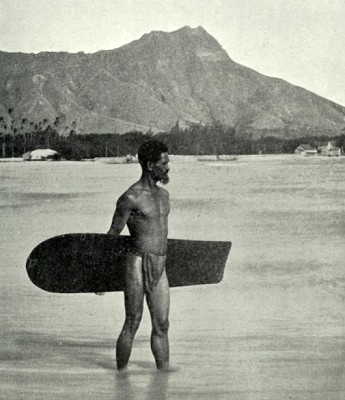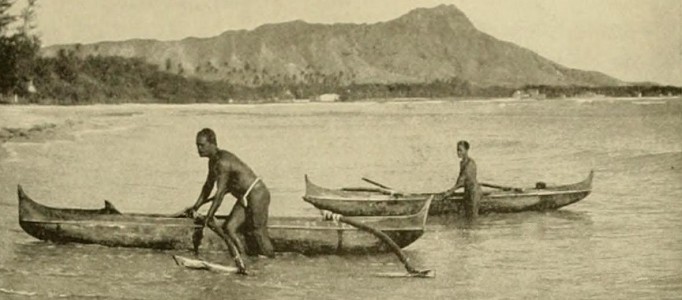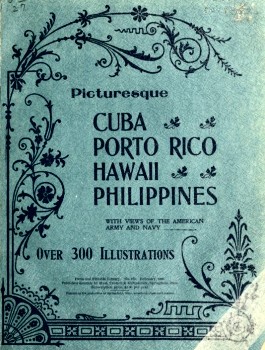
picturesque cuba, porto rico, hawaii, phillipines 1899.
| home | catalogue | history | references | appendix |
 |
surfresearch.com.au
picturesque cuba, porto rico, hawaii, phillipines 1899. |
Open
Library
http://openlibrary.org/books/OL528501M/Picturesque_Cuba_Porto_Rico_Hawaii_and_the_Philippines
There are two
photographs
of Waikiki, the first the widely reproduced Surf Board
Rider by
James J. Williams, circa 1893.
The second, is
of
two natives hauling their out-rigger canoes ashore.
They are
probably
the same natives and canoes.in a very similar photograph
published in John
R..Musick's Hawaii - Our
New Possesions,
in 1898.
Also note that
all
three photographs appear to be taken at almost the same
location on the
beach-front, relative to Diamond Head.
Commerce
and social
intercourse between the islands are very extensive. .
Several
local
steamship companies have complete lines of boats which run
continuously
on schedule time between the islands, with regular
stopping-places.
Besides
these,
many of the wealthier residents have hand some yachts or
launches, and
there are excursions along the coast
continually,
to say nothing of the native boats, which swarm everywhere.
Thus the
straits
between the islands are constantly alive with craft.
This
inter-island
traffic is one of the most fascinating phases of life in the
islands, rendered
so, doubtless, by the constant
danger to
those
engaged in it.
Here the
Kanaka
proves his worth.
The sea is
his
great text-book, his one theme of ecstasy, his field of
manly .sport, and
his grave.
Prior to
civilization
it was his god, and it has done more to develop his latent
energies, bravery,
hardihood, skill and endurance
than any
other
element or influence he has ever encountered.
In the sea
the
Kanaka is in his element, and the dangerous inter-island
navigation and
commerce is accomplished by him
under
difficulties
that would disconcert most seamen to the point of abandoning
the project.
Some of the
landings
are particularly dangerous.
At one place
on the island of Hawaii a village is built on the top of a
clitf, and passengers
are hoisted with a huge crane to which a chair is attached,
and swung two
hundred feet in the air to the top of the cliff.
Departing
travelers
are lowered by the same means to the boat, and thence rowed
out to the
ship in the harbor.
The native
Hawaiians
are nearly amphibious, and in their small canoes, with light
outrigger
to jire.serve their equilibrium, will brave a sea that would
swamp many
a stancher craft in the hands of less skilful seamen.
Often when a
wreck occurs on the coast and the sea runs so high that a
life-boat cannot
be gotten off, the natives will swim out to it, and if any
of the ship's
boats are still sound, they will almost certainly bring some
of the crew
safely to shore tlirough a sea which no white seaman would
attempt to brave.
Surf-riding
was
formerly the chief sport of the natives, but has fallen
somewhat into neglect.
The feat is
performed
on a carefully prepared slab of wood, rounded on one end,
and consists
in gaining and
Page 51
retaining
such
a position on one of the immense waves rolling in to shore
as to be carried
with fearful velocity toward the beach The more skilful of
the surf-riders
are still frequently seen standing erect, with arms folded,
on their little
planks, while rushing with terrific speed on the crest of
some monster
wave, which finally breaks with a roar and sends its burden
scooting over
the smooth water toward the sands of the beach.
Promiscuous
bathing
is indulged in by all ages and sexes, and although sharks
are numerous,
the natives are seldom caught. They always know when a shark
is in the
harbor, and act accordingly.
But even
should
they be surprised by the unexpected approach of one of the
monsters, they
are by no means apt to perish.
They will
float
calmly on the surface and gaze down into the clear water at
his sharkship,
watching his every move.
At the
moment
he rushes and turns on his side to grasp his prey the Kanaka
dives, and
the great jaws come together with notliing between them.
This is
repeated
until help comes.
Usually,
when
a
Page 52
shark is
known
to be present, the native goes into the water armed with a
piece of iron
about sixteen inches long and sharpened at both ends.
If the shark
appears, he will not only be cheated of his prey, but in all
probaiiility
will be seriously wounded, and perhaps killed.
It is said
that
some of the most daring of the natives will wait until the
shark turns
on his side and opens his mouth, and will then place the
iron perpendicularly
between his jaws, so that they are propped open.
The
Hawaiians
are very successful deep-sea fishermen, often going in their
frail canoes
out of sight of land.
Page 55
 |
Diamond Head in the Distance. James J. Williams : Surf Board Rider, circa 1893. [cropped] Also printed in Twombly, Alexander S. : Hawaii and Its People Silver, Burdett & Co., 1899, New York, 1899, page 35. and in Hannaford, E.: History And Description Of The Philippine Wonderland And Photographic Panorama Of Hawaii, Cuba, Porto Rico, Samoa, Guam, And Wake Island. The Crowell & Kirkpatrick Co., Springfield, Ohio, 1899, page 184
|
 |
Near Diamond Head. A
similar photograph,
Musick,
John R..
|
 |
A photographic panorama of our new possessions, Also life in the American Army and Navy, with portraits of the chief actors in the Spanish-American War. Over three hundred illustrations. Mast, Crowell & Kirkpatrik, Springfield, Ohio, 1899
|

| home | catalogue | history | references | appendix |